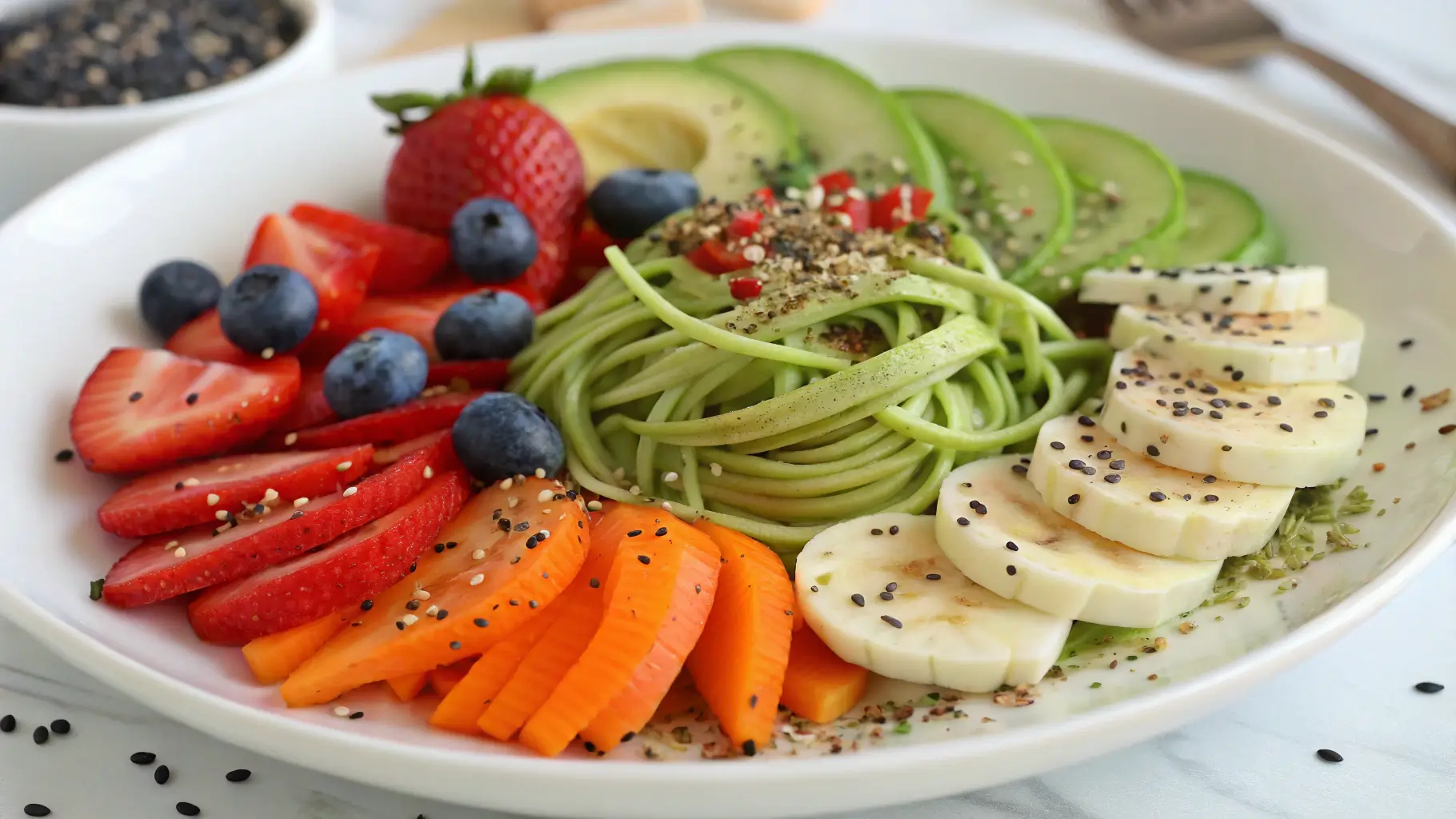The raw vegan Recipes lifestyle embraces uncooked plant foods in their most natural form. Dating back thousands of years yet finding renewed interest in modern wellness circles, this approach preserves foods’ integrity by avoiding temperatures above 118°F.
Raw veganism offers compelling health advantages: boosted immunity, enhanced digestion, sustained energy, and natural detoxification. By consuming fruits, vegetables, nuts, seeds, and sprouted grains in their unprocessed state, you maintain their complete nutritional profile and living enzymes.
This gentle food preparation method honors both your body and the environment. Whether you’re new to plant-based eating or looking to refresh your vegetable-forward routine, these accessible raw recipes will transform simple ingredients into vibrant, nourishing meals with minimal equipment and maximum flavor.
Table of Contents
Ingredients Raw Vegan Recipes
The foundation of delicious raw vegan recipes cooking lies in selecting fresh, high-quality ingredients. With a well-stocked pantry of plant-based staples and seasonal produce, you can create vibrant raw meals that satisfy both nutritional needs and culinary cravings. Explore a complete raw food grocery list at The Rawtarian.
Base Ingredients
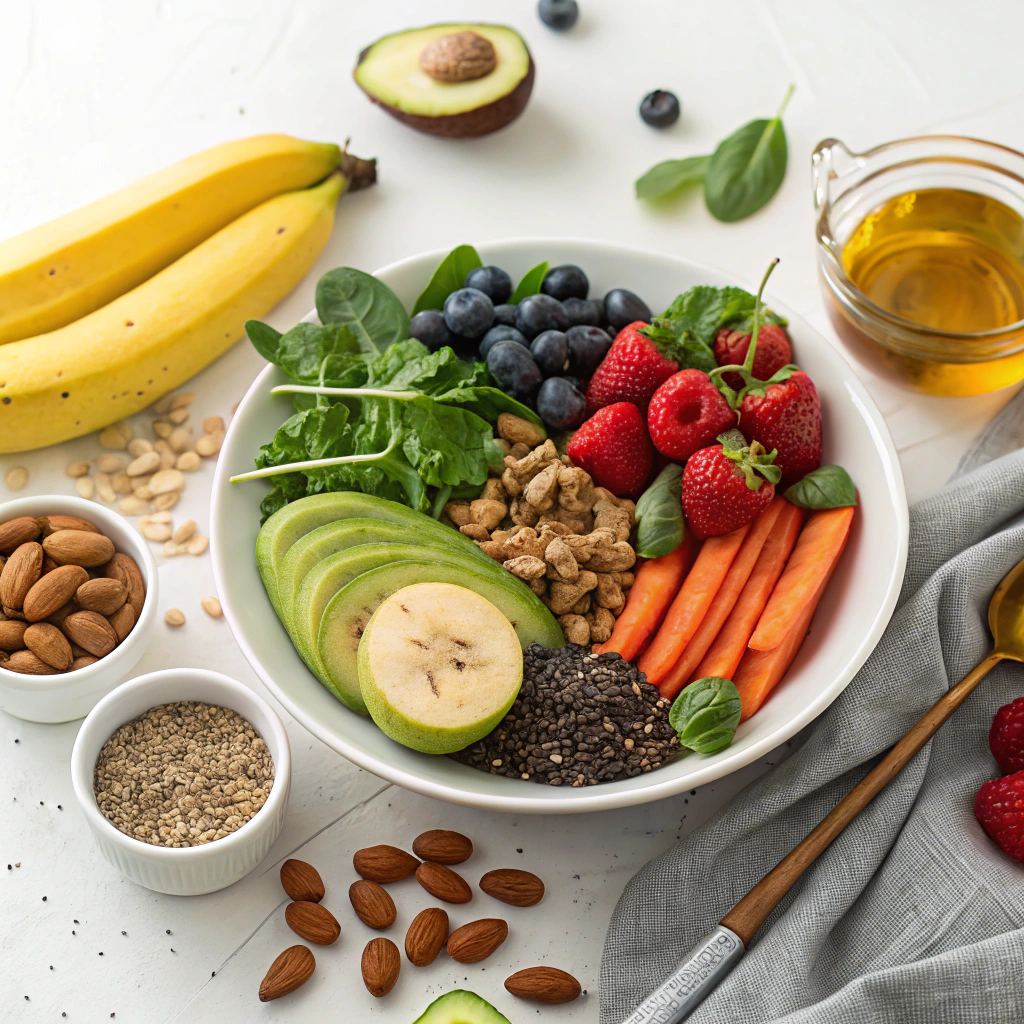
The raw vegan recipes kitchen relies on these nutrient-dense whole foods:
- Fresh fruits (berries, bananas, apples, mangoes)
- Vegetables (leafy greens, bell peppers, zucchini, carrots)
- Avocados for creamy texture and healthy fats
- Raw nuts (almonds, walnuts, cashews)
- Seeds (hemp, chia, flax, sunflower)
- Dried fruits, especially dates for natural sweetness
- Sprouted grains and legumes
- Cold-pressed oils (olive, coconut, avocado)
- Natural sweeteners (maple syrup, coconut nectar)
- Sea salt and natural seasonings
Flavor Enhancers
Elevate your raw dishes with fresh herbs like cilantro, basil, and mint. For seasoning, keep sea salt, nutritional yeast, cold-pressed tamari, and spices including turmeric, cumin, and cinnamon. Fresh lime and lemon juice brighten flavors, while garlic and ginger add depth to dressings and marinades.
Don’t forget superfoods like spirulina, cacao, and maca powder to boost nutrition and expand your raw recipe repertoire.
How to Make Raw Vegan Recipes
Creating raw vegan dishes requires different techniques than traditional cooking but can be just as satisfying. These methods preserve nutrients while transforming simple ingredients into flavorful meals that showcase the natural qualities of plant foods. Find essential raw vegan recipes preparation techniques from Raw Food Institute.
Essential Techniques
Blending and Processing
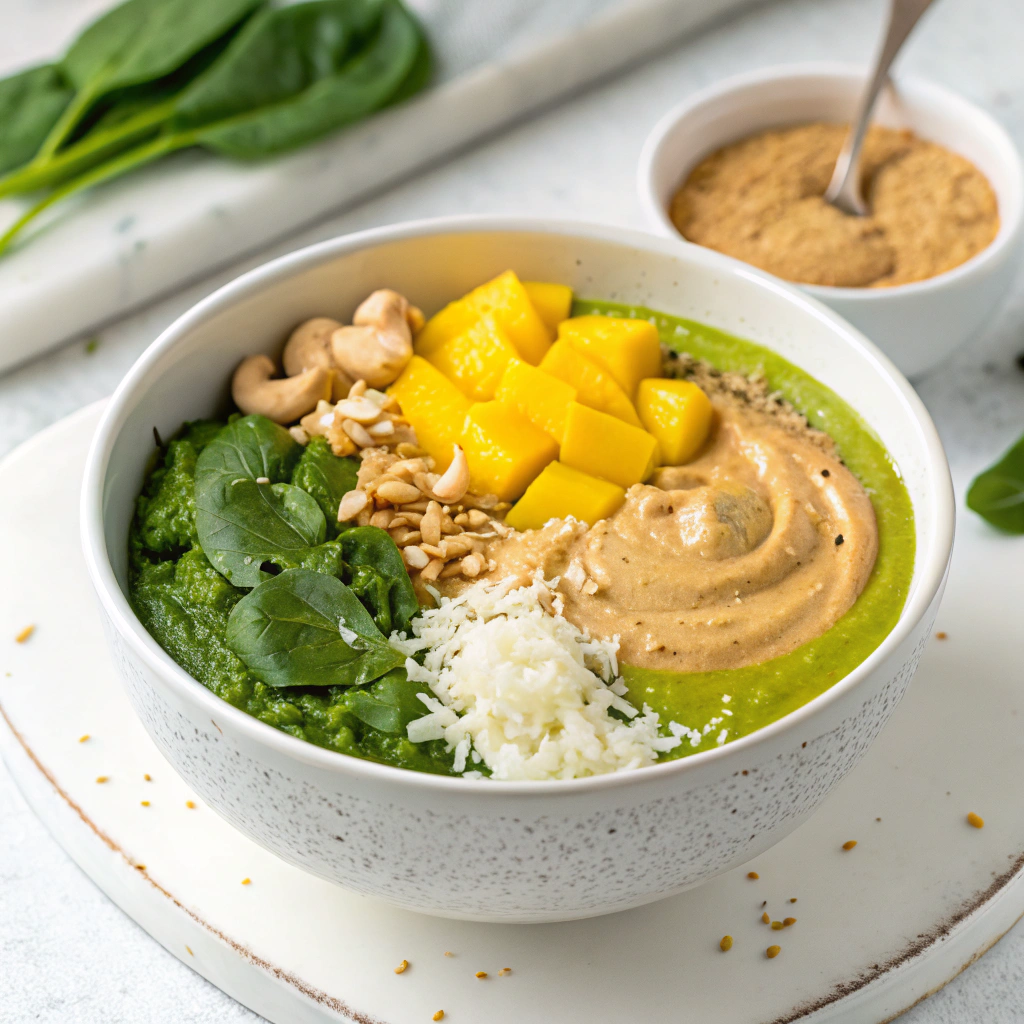
The blender and food processor are fundamental tools in raw food preparation. Use a high-speed blender to create smooth textures for soups, sauces, and smoothies. Blend soaked cashews with fresh herbs, a squeeze of lemon juice, and a pinch of sea salt to create a creamy, versatile sauce. Food processors work best for chunkier textures—pulse walnuts, sun-dried tomatoes, and herbs for raw taco “meat” or process dates with cacao and coconut for energy balls.
Spiralizing and Slicing
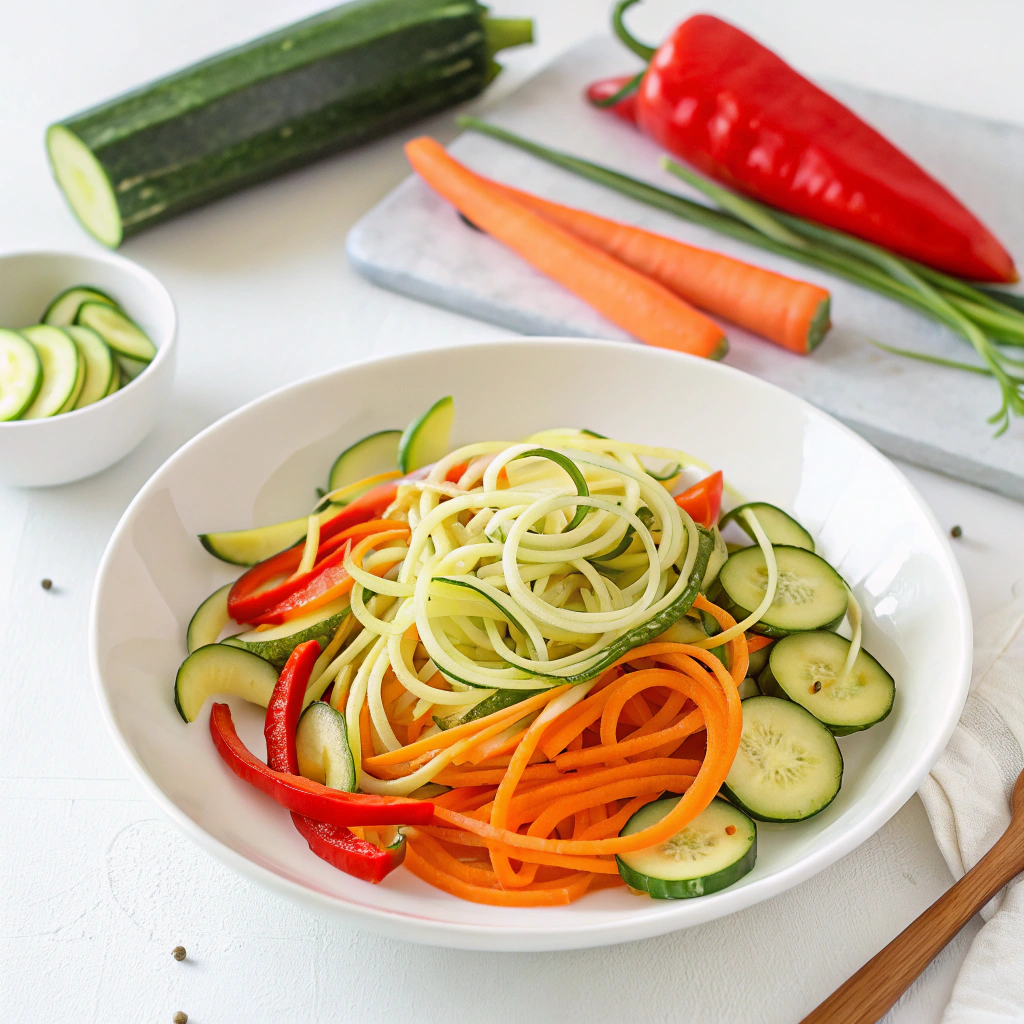
Transform vegetables into pasta-like strands using a spiralizer. Zucchini “noodles” make an excellent base for raw pad thai with a sauce of almond butter, lime juice, and tamari. For salads and wraps, use a mandoline to create paper-thin vegetable slices that add texture and visual appeal. Try whisper-thin cucumber ribbons tossed with dill and cold-pressed olive oil.
Soaking and Sprouting
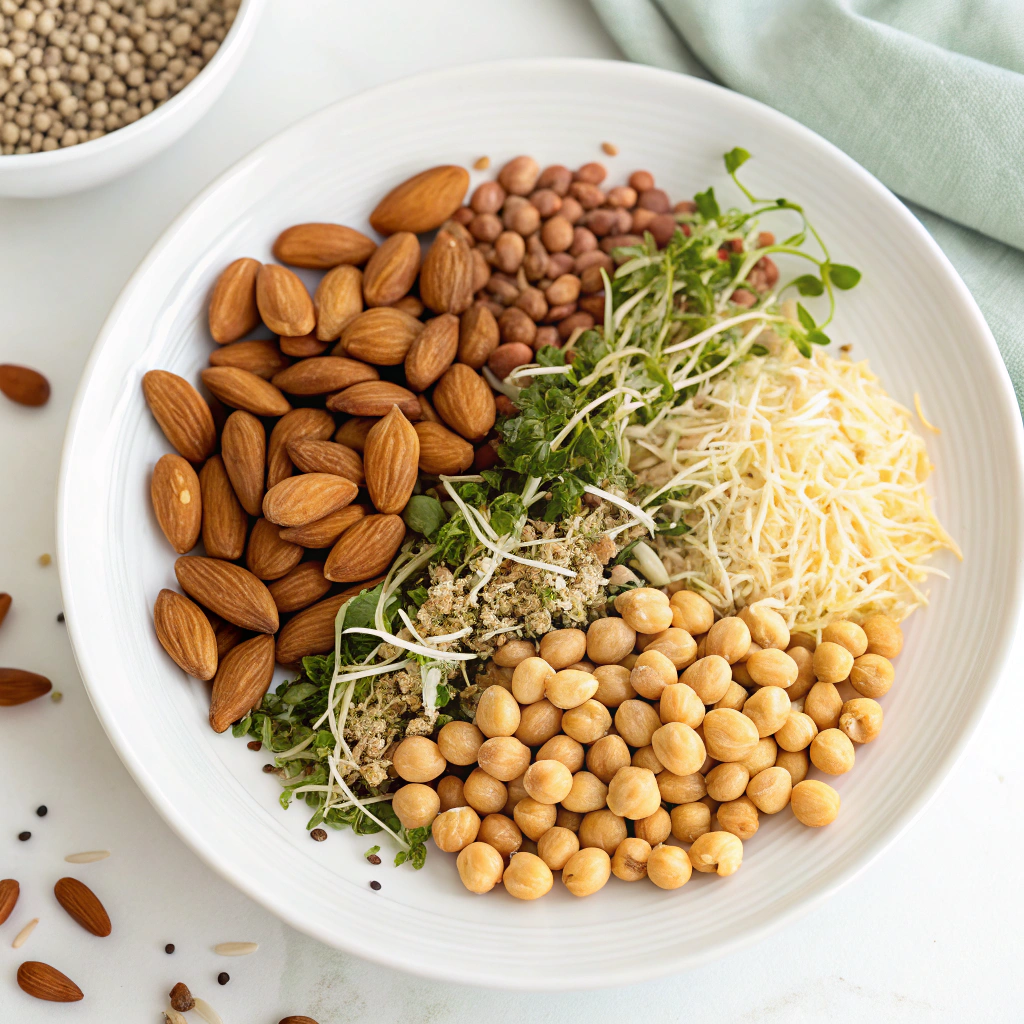
Soaking nuts and seeds activates their enzymes and improves digestibility. Soak almonds overnight, then blend with filtered water and strain for fresh nut milk. For sprouting, rinse chickpeas or lentils thoroughly, then leave in a jar with a mesh lid for 2-3 days, rinsing twice daily until tiny sprouts appear.
Serving Suggestions
Presentation elevates raw vegan recipes dishes from simple plant foods to elegant cuisine. These serving ideas enhance the visual appeal and flavor combinations of your creations while maintaining the integrity of the raw ingredients.
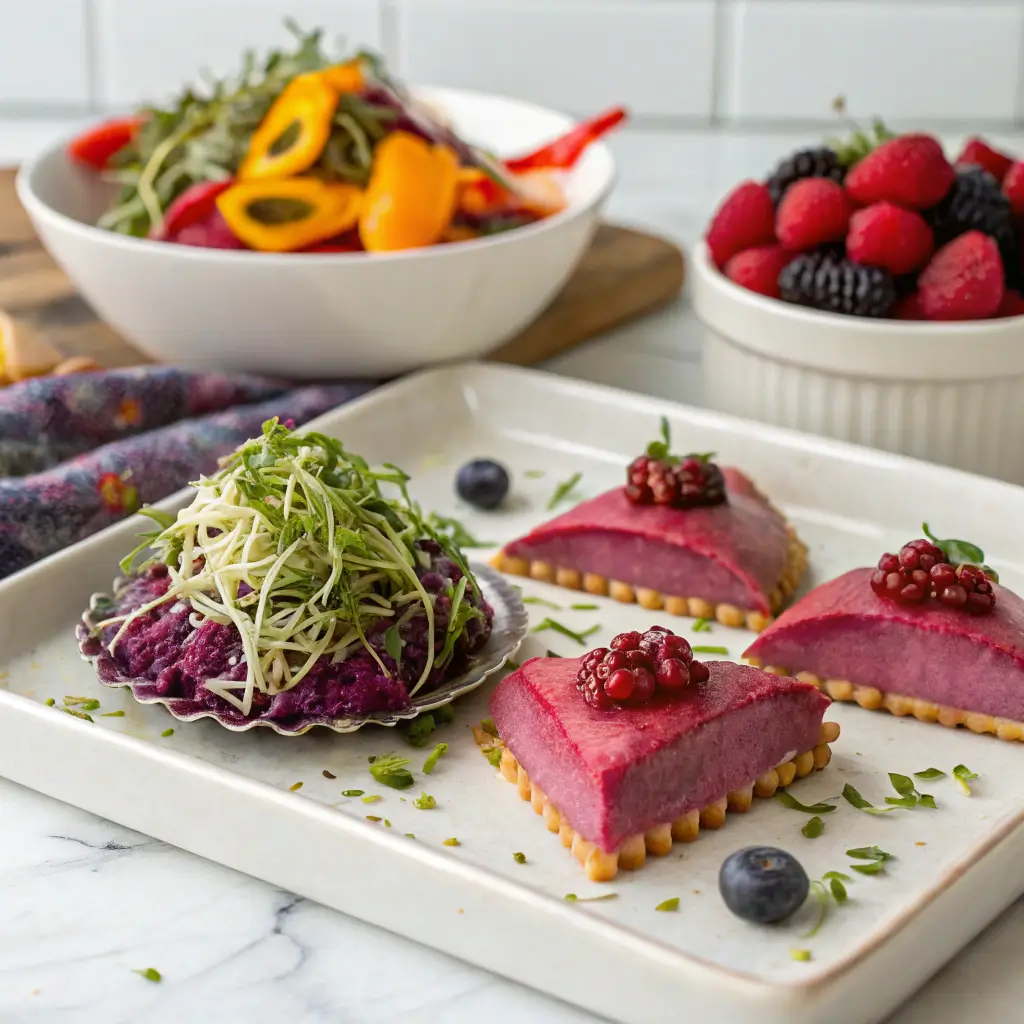
Plating Techniques
Color Composition
Raw vegan recipes foods naturally offer a stunning spectrum of colors. Design eye-catching plates by pairing contrasting colors together. Pair ruby-red beet ravioli with emerald microgreens, or layer a rainbow of vegetables in clear glasses for parfait-style presentations. For raw pad thai, arrange spiralized zucchini noodles as a vibrant base, topped with julienned red bell peppers, purple cabbage, and bright cilantro leaves.
Textural Elements
Balance is key when serving raw dishes. Combine creamy elements like avocado sauces with crunchy components such as dehydrated seed crackers or fresh vegetables. For raw cheesecake, contrast the smooth filling with a nutty crust and fresh berries. When serving raw soups, add texture with sprinkled hemp seeds or thinly sliced vegetables as garnish.
Complementary Pairings
Raw meals benefit from thoughtful accompaniments. Serve zucchini pasta with a side of marinated mushrooms for umami depth. Offer raw hummus with a variety of vegetable crudités for dipping. For desserts, pair raw chocolate treats with fresh seasonal fruits to cleanse the palate. Consider temperature contrasts too—slightly warmed (below 118°F) sauces can complement cool raw vegetable dishes beautifully.
Tips & Variations
Mastering raw vegan recipes becomes even more exciting when you understand how to customize them to suit your taste preferences and nutritional needs. These simple adjustments can transform basic recipes into diverse culinary experiences.
Creative Substitutions
Raw vegan cooking offers incredible flexibility. If a recipe calls for walnuts but you prefer cashews, make the swap. Sunflower seeds work well in place of hemp seeds in most dressings. When zucchini isn’t available, try cucumber for noodles, though they’re slightly more watery. Bell peppers of different colors can be interchanged based on what’s fresh and available.
Seasonal Adaptations
Adjust your raw recipes according to what’s in season. Summer brings juicy tomatoes perfect for gazpacho, while fall offers crunchy apples ideal for raw desserts. Winter citrus brightens key lime cheesecakes, and spring greens enhance salads. Working with seasonal produce not only improves flavor but also reduces environmental impact while supporting local farmers.
Raw vegan cooking thrives on experimentation. If a recipe doesn’t turn out perfect the first time, consider it a learning opportunity. The beauty of raw food lies in its forgiving nature – most ingredients can be adjusted until you achieve your desired taste and texture.
Nutritional Information Raw Vegan Recipes
Raw vegan recipes diets offer a wealth of essential nutrients when properly planned. Understanding the nutritional profile of these plant-based foods helps ensure you’re meeting your body’s needs while enjoying delicious meals. Get detailed raw vegan nutrition advice from Academy of Nutrition and Dietetics.
Micronutrient Density
Raw vegan dishes are usually rich in vitamins and minerals. Fresh vegetables like bell peppers provide more vitamin C than oranges, while dark leafy greens deliver calcium and iron. Avocados contribute vitamin E and healthy fats essential for nutrient absorption. Raw foods retain enzymes that might be diminished during cooking, potentially aiding digestion for some people.
Protein and Essential Nutrients
Contrary to common concerns, raw vegans recipes can obtain adequate protein through thoughtful food combinations. Hemp seeds provide all nine essential amino acids and offer around 10 grams of protein in just three tablespoons. Sprouted chickpeas increase their protein bioavailability, while walnuts and cashews provide both protein and healthy fats. For optimal nutrition, include a variety of nuts, seeds, sprouted legumes, and vegetables in your daily meals.
When transitioning to raw veganism, pay particular attention to vitamin B12, vitamin D, and omega-3 fatty acids. Consider speaking with a nutrition professional to determine if supplements might benefit your specific dietary pattern and health needs.
FAQs
hat can I eat as a raw vegan?
Raw vegans eat uncooked plant foods including fresh fruits, vegetables, nuts, seeds, sprouted grains and legumes. Avocados, cold-pressed oils, fermented foods like raw sauerkraut, and dehydrated snacks (kept below 118°F) are also part of the diet. Focus on variety to ensure nutritional balance.
Can you survive as a raw vegan?
Yes, with proper planning, many individuals flourish on raw vegan diets.The key is ensuring adequate caloric intake and nutritional diversity. Some people may need supplements for vitamin B12, vitamin D, and omega-3 fatty acids. Consult with a healthcare provider before making this dietary change.
What does a raw vegan eat for breakfast?
Raw vegan breakfasts include fruit smoothies, chia puddings, overnight oats soaked in plant milk, fresh fruit platters, raw granola with plant milk, avocado with sprouts on raw crackers, or green smoothie bowls topped with nuts and seeds.
Can raw vegans eat rice?
Traditional rice is not raw vegan as it requires cooking. However, some raw vegans eat sprouted wild rice or use cauliflower “rice” as alternatives. Sprouting makes some grains more digestible without cooking.
Do raw vegans drink coffee?
Most strict raw vegans avoid coffee as beans are roasted at high temperatures. Alternatives include cold-brewed herbal teas, raw cacao drinks, and dandelion root tea.
Do raw vegans eat eggs?
No, raw vegans avoid all animal products, including eggs. The diet is based entirely on plant foods.
Is hummus raw vegan?
Traditional hummus is not raw vegan because chickpeas are typically cooked. However, raw versions exist using sprouted chickpeas, raw tahini, olive oil, lemon juice, and garlic.
How do raw vegans get protein?
Raw vegans get protein from nuts, seeds (especially hemp and chia), sprouted legumes, dark leafy greens, and nutritional yeast. Eating a variety of plant-based proteins throughout the day helps maintain a balanced intake of essential amino acids.
Is peanut butter raw vegan?
Most commercial peanut butter isn’t raw vegan as peanuts are typically roasted. Raw peanut butter made from unroasted peanuts exists but is less common. Many raw vegans opt for raw almond or cashew butter instead.
Conclusion & Call to Action
Raw vegan recipes offer a fresh approach to plant-based eating that preserves natural flavors and nutrients. By incorporating these simple, unprocessed dishes into your routine, you’re embracing foods in their most natural state.
Whether you’re fully committed to raw veganism or simply adding more raw meals to your diet, the benefits for your health and energy levels can be significant. Begin by introducing one raw dish daily and expand your repertoire as you build confidence with the unique preparation methods.
We’d love to hear about your raw vegan recipes cooking adventures! Share your experiences, modifications, and questions in the comments below. Your journey might inspire others to discover the vibrant world of raw plant-based cuisine.

